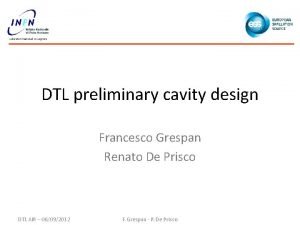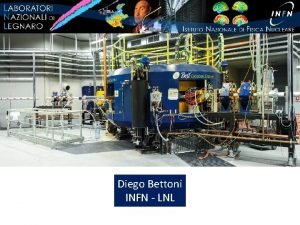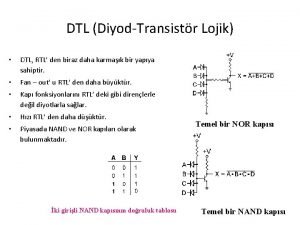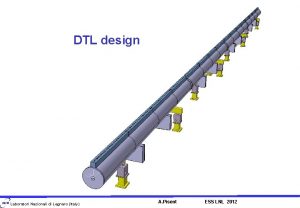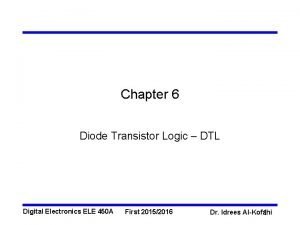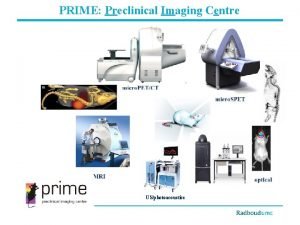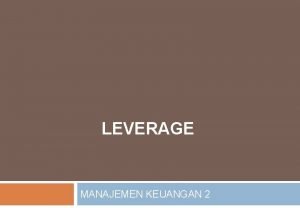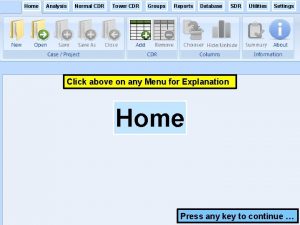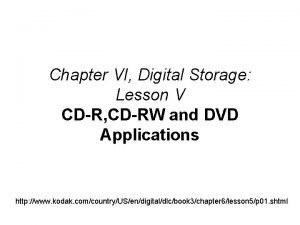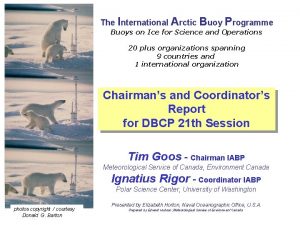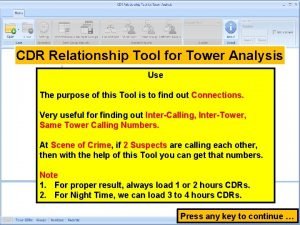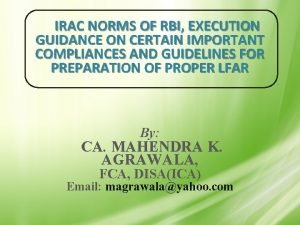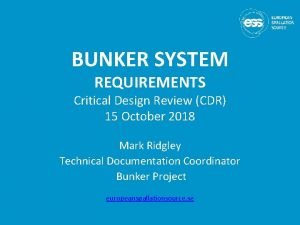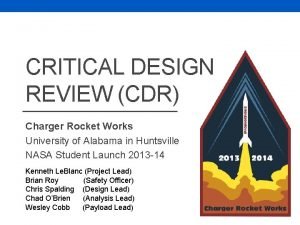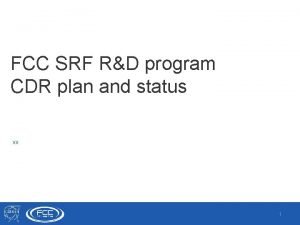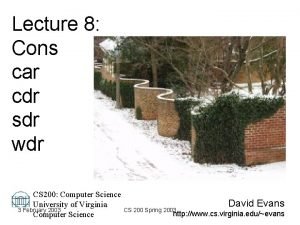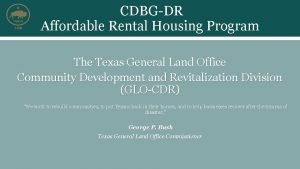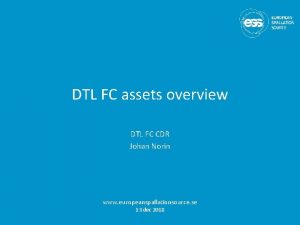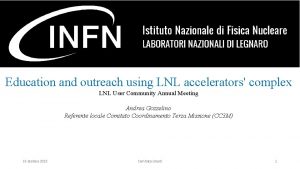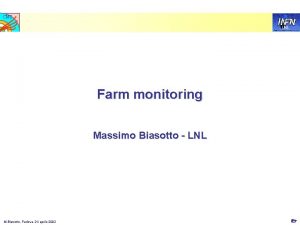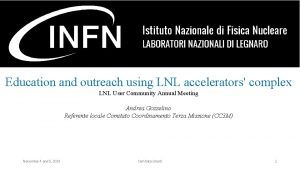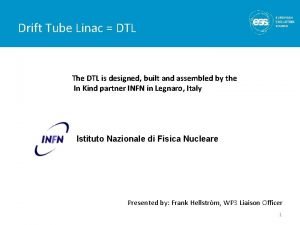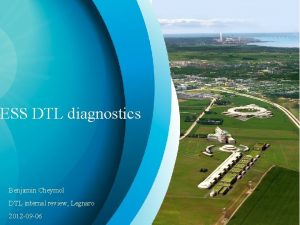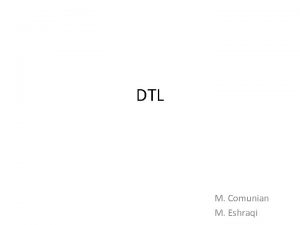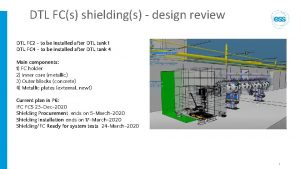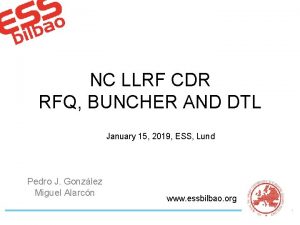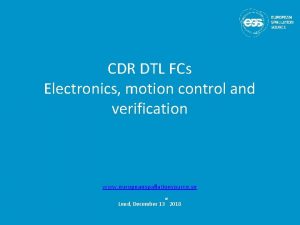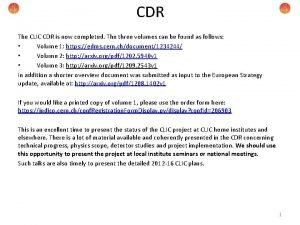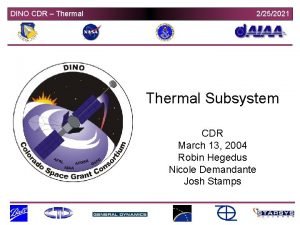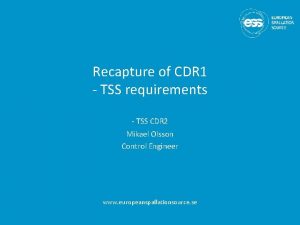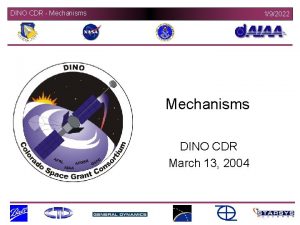DTL RF properties F Grespan LNL 20150622 CDR


























- Slides: 26

DTL RF properties F. Grespan LNL - 2015_06_22 CDR F. Grespan

Contents • • RF properties of tanks Tuning Thermo-mechanical simulations RF couplers Post couplers Pick up PMQ prototype Steerer EM design LNL - 2015_06_22 CDR F. Grespan

ESS DTL RF properties Tank 1 2 3 4 5 Cells 61 34 29 26 23 E 0 [MV/m] 3. 00 3. 16 3. 07 3. 04 3. 13 Emax/Ek 1. 55 φs [deg] -35, -25. 5 LTank [m] 7. 62 7. 09 7. 58 7. 85 7. 69 Diam Tank [mm] 520. 5 RBore [mm] 10 11 11 12 12 N. PMQ - 1 st/last cover 31 - Y/N 18 -Y/Y 15 - N/Y 13 - N/N 12 - Y/N Radius PMQ [mm] 11 12 12 13 13 LPMQ [mm] 50 80 80 Tun. Range [MHz] ± 0. 75 Q 0/1. 25 42512 44455 44344 43894 43415 Optimum β 2. 01 2. 03 2. 01 1. 91 1. 84 Optimum Detuning [k. Hz] +2. 3 +2. 0 +1. 8 Pcu [k. W] (no margin) 870 862 872 901 952 Eout [Me. V] 21. 29 39. 11 56. 81 73. 83 89. 91 PTOT [k. W] 2192 2191 2196 2189 2195 LNL - 2015_06_22 CDR F. Grespan

DTL cells and tank design • • • Even if the cells, different in length, have the same frequency, the accelerating field is not constant because there is NOT a perfect mode matching between the adjacent cells built individually. The phase variation implies a cell length variation. The tilt that results from a cell length variation, have been compensated cell by cell tuning of Face Angle fine tuning also compensated frequency effect of STEM R. De Prisco et al. THPME 041, IPAC 2014 proceedings LNL - 2015_06_22 CDR F. Grespan

DTL tank design • • • This tuning can be verified only by 3 D simulation of tank 5 show a 2. 5% error on field flatness (simulation of tank 1 error is 5%) A margin of 2 on the tuning range is considered in order to compensate field flatness error LNL - 2015_06_22 CDR F. Grespan

Breakdown risk mitigation • • Enhancement of sparking risk in presence of magnetic field. Assumption of scaling with Kilpatrick criterion (Mu. Cool program at Fermi. Lab). 3 D simulation of first 15 ESS DTL cells with Halbach PMQ inside the tube. PMQ MAX Gradient = 62 T/m. PMQ Length = 50 mm in the first tank. Maximum surface field is at R=12 mm. In the first cell: Elimit =1. 45 Ekilp. - Design : 1. 20 Ekilp. Risk of multipacting reduced by minimizing parallel surfaces: F = 0. 3 cm. LNL - 2015_06_22 CDR F. Grespan

Static frequency budget and tuners • • Tuners compensate construction errors Evaluation with realistic tolerances on important dimensions (tank diameter, drift-tube lengths, drift tube diameter, face angles) Movable tuners compensate thermal deformations in operation 1 st cell of Tank 1 is the most sensitive → taken for all cells as a margin Cell 1 of Tank 1 Nominal [mm] Sensitivity [KHz/mm] Tolerance [mm] Static Error [KHz] GAP_Length 13. 13 5187 ± 0. 025 ± 130 FACE_Angle 5. 72 deg 6684 ± 0. 025 ± 167 DT_Diameter 90 -1191 ± 0. 025 ∓ 30 TANK_Diameter 520. 5 -451 ± 0. 100 ∓ 45 STEM_Diameter 28 132 ± 0. 025 ± 3 Total • Static error compensated by Tuners = ± 750 KHz (+100% margin) • Superfish frequency target (stem included)= 352. 21 MHz – 0. 75 MHz = 351. 46 MHz • The tuner sensitivity (diam=100 mm) = 7. 0 (k. Hz/mm)×m • Extra power for tuners (24 tuners/tank, Nom. Penetration=35 mm) = +2. 1% LNL - 2015_06_22 CDR F. Grespan ± 375

Thermo mech. simulation 1 st cell tank 1 Δf=-10 k. Hz LNL - 2015_06_22 CDR Last cell tank 5 Δf=-25 k. Hz F. Grespan

Frequency tuning in operation • Max simulated cell detuning in operation= 25 k. Hz (tank 5) • Water nominal temperature = 30 deg • Temp sensitivity= -10 k. Hz/deg • water frequency range = +40 k. Hz (@26°C), -100 k. Hz (@40°C) • Operating water temperature will be optimized in RF conditioning phase • 3 movable tuners/tank, tuning range= +120 k. Hz (@ penetration=80 mm), - 90 k. Hz (@penetration=0 mm) LNL - 2015_06_22 CDR F. Grespan

RF Tuning sequence 1. 2. 3. 4. 5. 6. 7. 8. 9. 10. 11. 12. 13. 14. Alignment of DTs (0. 1 mm) provides cell by cell field flatness End walls and tuners provide Higher order harmonics tuning Tuning of RF coupler perturbation Field flatness goal = 2% Insertion of post coupler Post coupler average length fixed with dispersion curve method Artificial tilt of field changing end cell tuning Fine tuning of post coupler length Fine frequency tuning for nominal temperature 30°C Final machining of post couplers, tuners, end plates Measure of Qvalue Fine tuning of RF couplers to achieve optimum coupling β High power conditioning Fine temperature tuning to minimize movable tuner stress in operation LNL - 2015_06_22 CDR F. Grespan

Longitudinal misalignment of Cells (Tank 1) Error ranges: ± 50 - ± 100 - ± 200 micron Statistic: 100 runs per range Distribution: uniform LNL - 2015_06_22 CDR F. Grespan 50 micron = +0. 1% error 100 micron = +0. 2% error 200 micron = +0. 4% error

RF coupler design P tot W Q 0 MHz LNL - 2015_06_22 CDR F. Grespan MDT Fish Data HFSS T 1_C 26_27 47. 13 30166 30591 351. 764 351. 082

RF coupler design Aperture=50 mm Heigth = 76. 8 mm Beta rescaled = 1. 23 Detuning cells 26 -27 = -3. 2 MHz (local detuning on 23 cm) Dedicated tuner located RF at coupler section LNL - 2015_06_22 CDR F. Grespan

RF coupler design • • H 0=3. 7 k. A/m (superfish) Hmax= 11 k. A/m Rs=0. 004896 Ohm Max Power density = (Hmax 2)x Rs/2 x 5%=1. 5 W/cm 2 LNL - 2015_06_22 CDR F. Grespan

Bandwidth and Beam loading Optimum detuning Effective sync. phase Optimum coupling Parameter/Tank 1 2 3 4 5 Peak Pcu [MW] (1. 25 margin) 1087 1077 1090 1126 1190 Pbeam [MW] 1103 1113 1105 1024 1004 Optimum coupling 2. 01 2. 03 2. 01 1. 91 1. 84 Q 0 (margin 1. 25) 42512 44455. 6 44345 43895 43416 Optimum detuning [MHz] 352. 2123 352. 2120 352. 2118 3 d. B bandwidth (0. 5 power) ± 12. 5 k. Hz ± 12. 0 k. Hz ± 11. 7 k. Hz ± 11. 5 k. Hz ± 6. 0 k. Hz ± 5. 8 k. Hz ± 5. 7 k. Hz 1 d. B bandwidth (0. 8 power) ± 6. 2 k. Hz Filling Time [micros] 12. 7 13. 2 13. 3 13. 6 13. 8 Required Pgen/(Pcu+Pbeam) in case of detuning=0 1. 021 1. 016 1. 014 LNL - 2015_06_22 CDR F. Grespan

RF coupler phase and tuning R i 1 Z 2 i 2 • Unbalance between RF couplers generates reflected power. • RF Coupler tolerances (phase Δθ, coupling β, power splitting) should take into account power margin • coupling β is responsibility of INFN-LNL • Accuracy around β=1 → 1 mm on short length = 1% on β LNL - 2015_06_22 CDR F. Grespan

RF windows • Linac 4 RF windows: duty cycle applied was 1 ms pulses at 2 Hz, @1 MW • Request to Mega for - Half heigth WR 2300 freq = 352. 21 MHz return loss > 30 d. B insertion loss > 30 d. B FWD peak power: 1. 3 MW all phase FWD average power: 70 k. W Vacuum: 10 e-8 mbar • Order for 10 RF windows, confirmed after high power test of 1 st window (contact with CEA ESS test bench) LNL - 2015_06_22 CDR F. Grespan

Post couplers Parameter /Tank 1 2 3 4 5 Cells per cavity 61 34 29 26 23 PC distance [m] 0. 35 0. 33 0. 35 0. 32 0. 33 N PCs 24 23 28 25 22 N PCs / N cells First 12 cells: 1/4 Second 18 cells: 1/3 Others: 1/2 First 20 cells: 1/2 Others: 1/1 1/1 Detuning [MHz] L_post = 19 cm 0. 17 0. 20 0. 17 Power [MW] (no duty cycle considered) 0. 031 0. 036 0. 044 0. 031 LNL - 2015_06_22 CDR F. Grespan

Post coupler • Post coupler distribution is compliant with stabilization requirements and mechanical constraints • Thermal and static results for Copper Post coupler are: – Temp: + 10. 7°C – Thermal elongation: + 44 micron – Static bend: -9 micron LNL - 2015_06_22 CDR F. Grespan

Pick-up characteristics Pick-up location along the tank 9 pick-ups are symmetrically located with respect to the tank center in order to suppress higher order TM modes for LLRF control. LNL - 2015_06_22 CDR F. Grespan

PMQ prototype Rare earth block specifications (Sm 2 Co 17): - Error Br < 3% Error an Angle < 2 deg Dimension tolerances < 0. 05 mm – 0. 1 mm Br=1. 1 T → Simulated Gradient=65 T/m Assembly specifications: - Housing Material - Stainless Steel (316 LN) Outgassing rate per magnet below 4. 10 -6 mbar l s-1 Gradient integral error (rms) -+ 0. 5 % Magnetic versus geometric axis: < 0. 1 mm Harmonic content at 10 mm radius: Bn/B 2 for n=3, 4, . . . 10: < 0. 01 Roll: 1 mrad Goal: - define assembly criticalities verify feasibility of specifications define magnetic measurement bench and procedure tunability of PMQ Company qualification LNL - 2015_06_22 CDR F. Grespan

PMQ prototype See vacuum presentation LNL - 2015_06_22 CDR F. Grespan

Steerer EM design Dipole Strength Dipole Length Inner radius maximum external radius B ampere turn conductor radius water channel radius cu-area n turns current density condutor length copper resistivity Conductor resistance Volt Power DC (single steerer) Vector potential 0. 0016 T*m 30 mm 28 mm 33 mm 0. 0533 T 976. 33 A 2. 3 mm 1. 5 mm 9. 55 mm^2 4 244. 1 A 25. 56 A/mm^2 2 m 1. 70 E-08 Ohm*m 0. 0036 Ohm 0. 869 V 212. 10 W LNL - 2015_06_22 CDR Magnetic flux density T F. Grespan

Conclusions • RF properties of 5 tanks are defined • Static and dynamic tuning range is defined (Mechanical tolerances, RF simulation and thermo-mechanical simulations) • Size of RF couplers is defined, effect on frequency and field detuning will be compensated by dedicated tuner, power density is calculated. Multiple coupler unbalances (phase, coupling, amplitude) must be negotiated with ESS RF group. • N° and distribution of Post couplers is compliant with Stabilization and mechanical constraints. Thermo-mechanical simulations done. • Pick up design and distribution is done • PMQ prototype produced and characterized • Steerer preliminary EM design is done, compatible with available space in the drift tube. LNL - 2015_06_22 CDR F. Grespan

Back up slide 1 LNL - 2015_06_22 CDR F. Grespan

Back up slide 2 LNL - 2015_06_22 CDR F. Grespan
 Francesco grespan
Francesco grespan Infn lnl
Infn lnl Lnl kona
Lnl kona Dtl nedir
Dtl nedir Asc 740
Asc 740 Dtl design
Dtl design Dtl logic
Dtl logic Dtl prime
Dtl prime Apa itu leverage
Apa itu leverage Deferred tax asset journal entry
Deferred tax asset journal entry Ketan computers cdr analysis
Ketan computers cdr analysis Cdr analysis in excel
Cdr analysis in excel Cdr vs cdrw
Cdr vs cdrw International arctic buoy program
International arctic buoy program Abstract cdr
Abstract cdr Financial restructuring definition
Financial restructuring definition Pdr cdr project management
Pdr cdr project management Cdr
Cdr Cdr analysis in excel
Cdr analysis in excel Irac norms
Irac norms Cdr critical design review
Cdr critical design review Radiology
Radiology Net population growth formula
Net population growth formula Cdr design review
Cdr design review Program cdr
Program cdr Cdr winkel
Cdr winkel Cdr rental
Cdr rental
